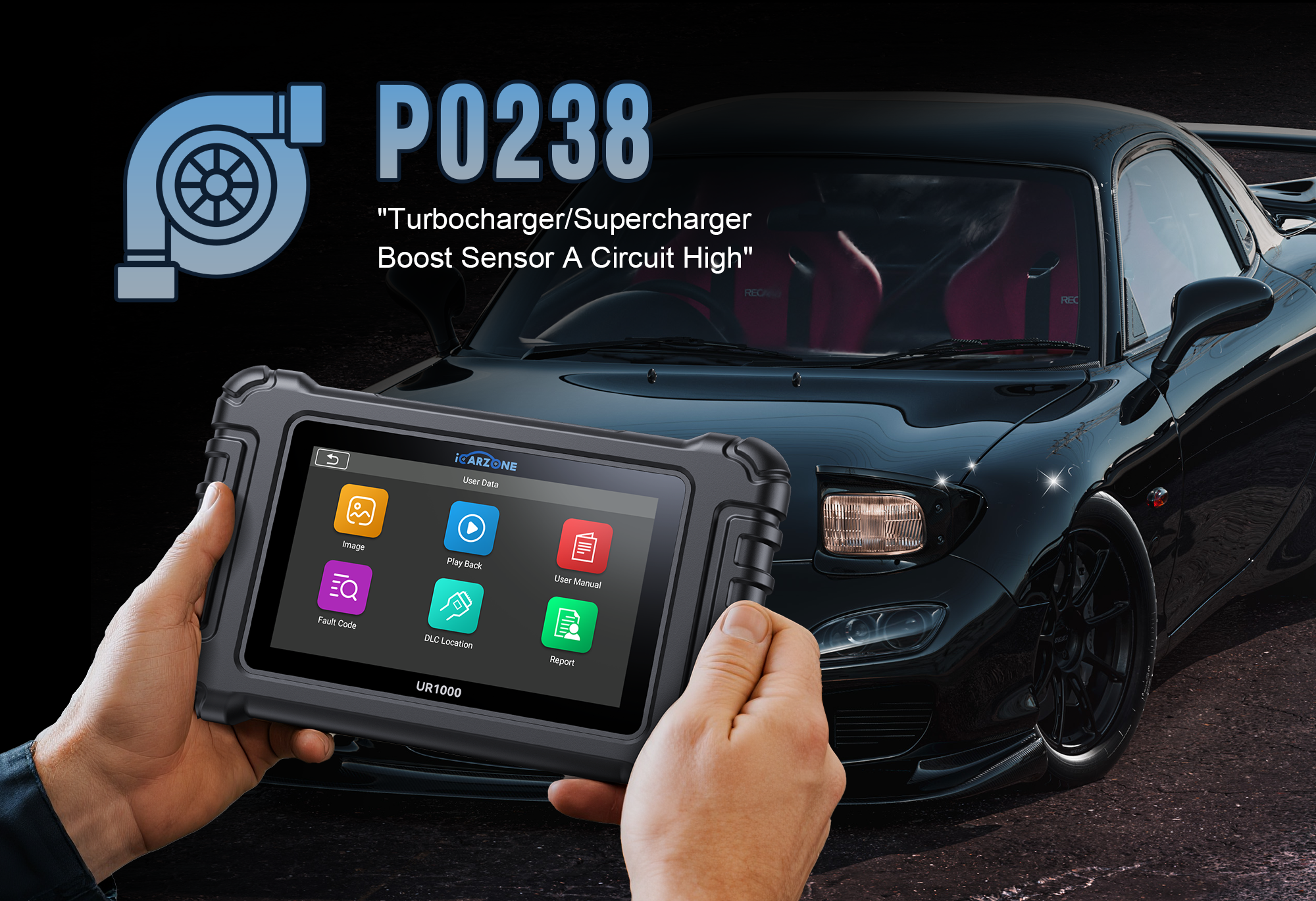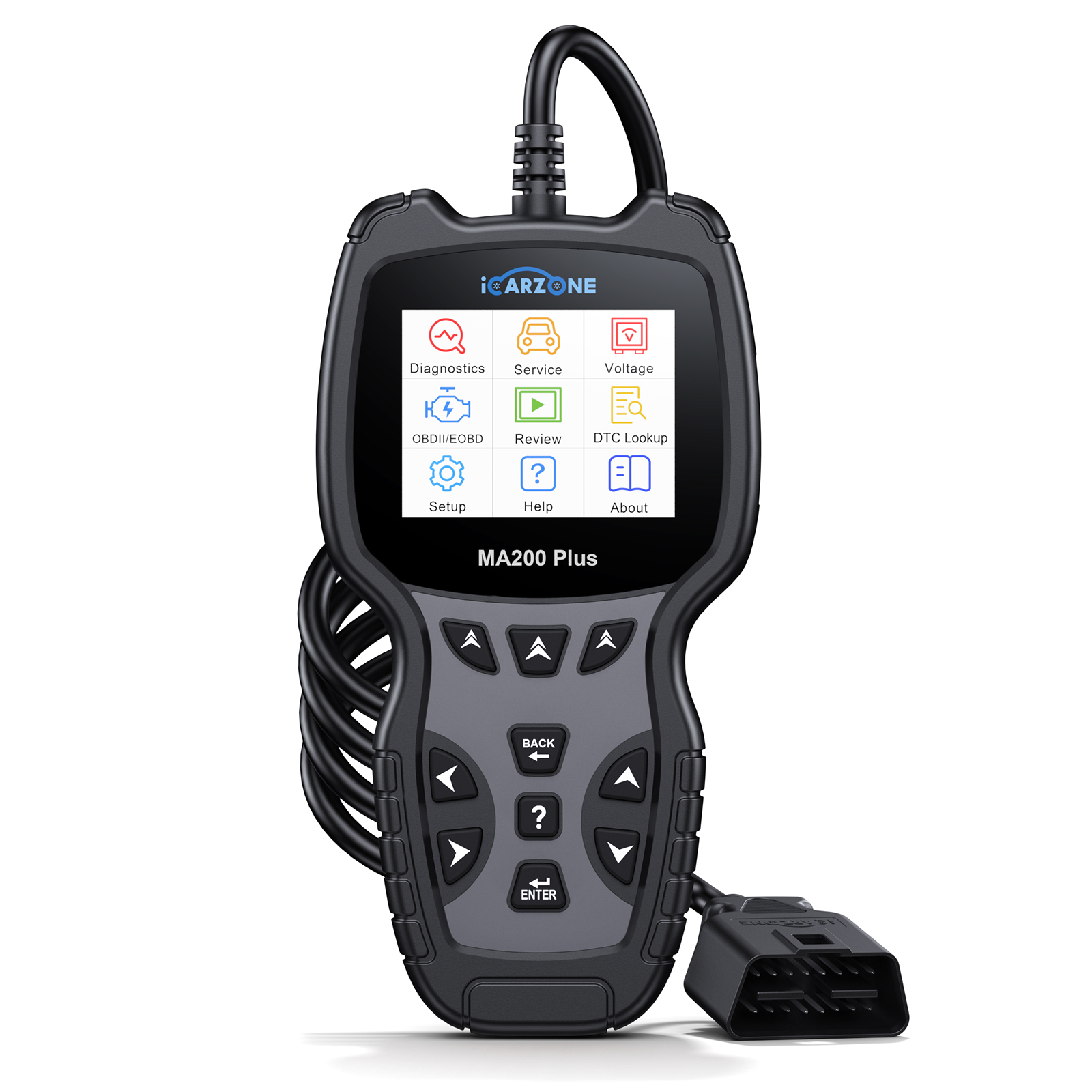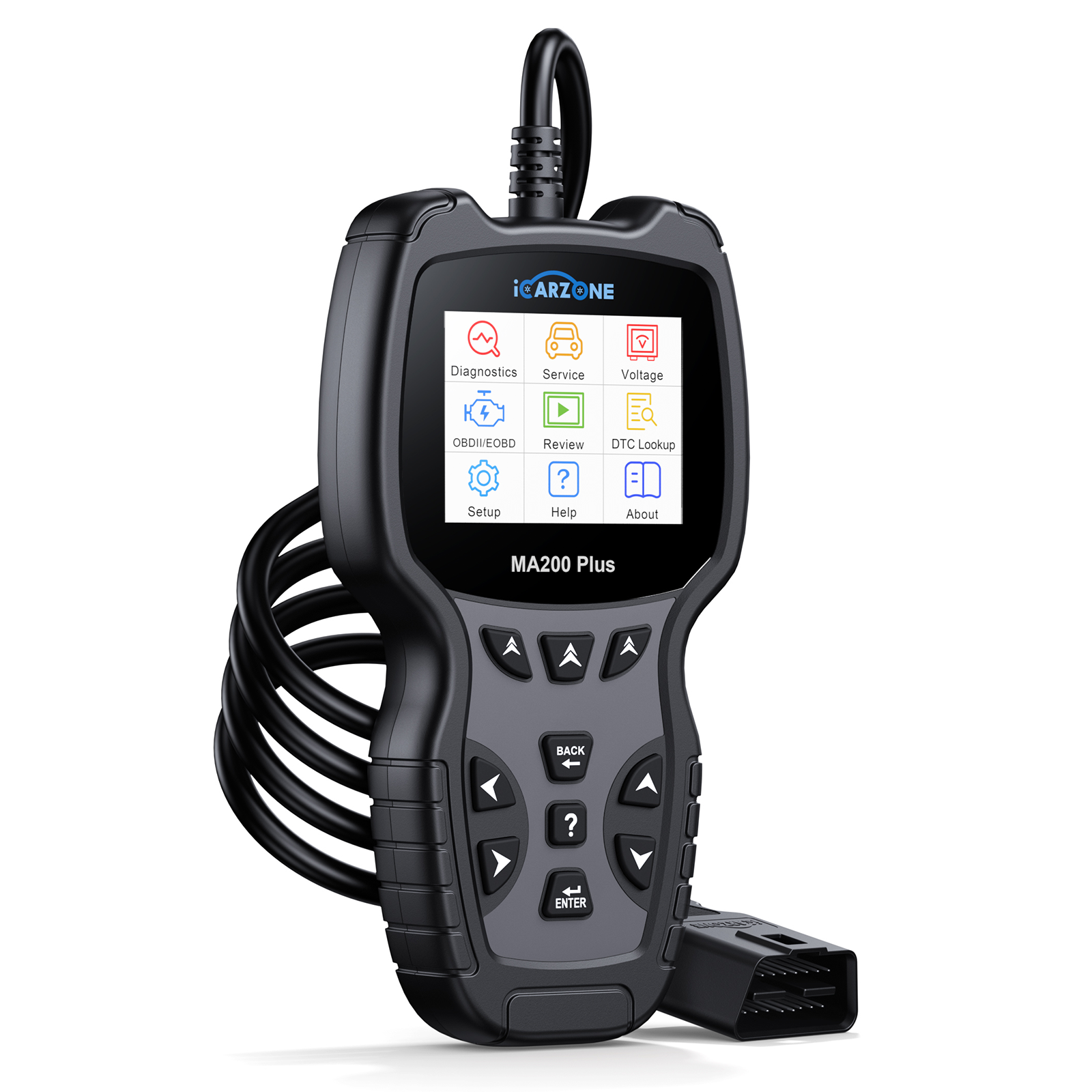P0238: Turbocharger Boost Sensor A Circuit High | Comprehensive Fix Guide

P0238: Turbocharger Boost Sensor A Circuit High | Comprehensive Fix Guide
Published by ICARZONE: August 13, 2025Demystify the P0238 error code. Dive deep into what triggers it, how to accurately diagnose turbo boost sensor problems, and discover tried-and-true solutions to restore optimal boost pressure regulation in your vehicle.
View Compatible Tools1. What is P0238?
P0238 is a diagnostic trouble code signifying Turbocharger/Supercharger Boost Sensor A Circuit High. This code is activated when the Engine Control Module (ECM) detects an anomalously high voltage signal from the turbocharger boost pressure sensor. Usually, this means the voltage has surpassed the manufacturer's set thresholds, often around 4.5V or higher.
Why Boost Sensors Are Indispensable
Boost pressure sensors, sometimes known as manifold absolute pressure sensors in turbocharged setups, are tasked with monitoring the pressure of the compressed air generated by the turbocharger. This data is of utmost importance as it enables the ECM to: Fine-tune the fuel injection timing and the amount of fuel injected. Control the operation of the turbocharger's wastegate, which helps regulate boost pressure. Protect the engine from the detrimental effects of excessive boost pressure, which could lead to engine damage. Optimize the vehicle's performance and fuel efficiency by ensuring the right air-fuel mixture.
Under normal circumstances, the output voltage of a boost sensor typically ranges from 0.5V (representing low boost pressure) to 4.5V (indicating maximum boost). When the ECM receives a voltage signal that exceeds this normal range, it sets the P0238 code as a means to safeguard the engine from potential harm.

2. Potential Causes & Real-World Examples
The P0238 code can be the result of either electrical glitches in the boost sensor circuit or an actual overboost condition. Here are some common causes along with real-world scenarios:
-
Faulty Boost Pressure Sensor
Example: In a 2019 Ford F-250 Powerstroke, an internal failure within the boost pressure sensor led to a constant 5V output, regardless of the actual boost pressure. Replacing the sensor successfully resolved the P0238 issue. -
Damaged Wiring or Connectors
Example: A 2017 Volkswagen Golf GTI had its wiring chewed by rodents, creating a short to the 12V power supply. This caused a high voltage signal to be sent to the ECM. Once the damaged wiring harness was repaired, the P0238 code cleared. -
Turbocharger Overboost Condition
Example: In a 2020 Dodge Ram 2500 Cummins, the wastegate actuator got stuck, allowing uncontrolled boost pressure. The boost pressure exceeded 40 psi, while the normal maximum is around 30 psi. Repairing the wastegate restored normal boost pressure operation. -
Boost Control Solenoid Failure
Example: In a 2018 Audi S4, a failed boost control solenoid prevented the wastegate from activating. As a result, the boost pressure built up beyond the safe limits. Replacing the solenoid fixed the overboost problem. -
ECM Software or Hardware Issues
Example: A 2021 Chevrolet Silverado Duramax had an ECM calibration error that caused it to misinterpret the boost sensor values. An ECM software update corrected the voltage threshold settings, resolving the P0238 issue.

3. Symptoms
When your vehicle is grappling with a P0238-related problem, the following symptoms are commonly observed:
- Illuminated Check Engine Light: The most obvious sign, with the check engine light specifically indicating the presence of the P0238 code.
- Reduced Engine Performance: To protect the engine from excessive boost, the ECM may enter limp mode, significantly reducing power output. This results in a noticeable decrease in acceleration and overall engine performance.
- Unusual Turbocharger Noise: You might hear whistling or whining sounds coming from the turbocharger area. These noises are often an indication of abnormal boost pressure levels.
- Engine Hesitation or Surging: Erratic power delivery can occur as the ECM struggles to manage the incorrect boost pressure readings, leading to hesitation during acceleration or sudden surges of power.
- Decreased Fuel Economy: The ECM may compensate for the perceived high boost pressure by enriching the fuel mixture, which can lead to increased fuel consumption.
- Engine Overheating: In severe and prolonged cases of overboost, the engine may experience elevated operating temperatures due to increased combustion pressures and temperatures.
4. Vehicles Prone to P0238
Certain turbocharged vehicles are more susceptible to P0238 due to their boost sensor design, turbocharger configuration, or common manufacturing issues. Here are some models that frequently encounter this code:
- Ford F-Series Powerstroke (2011–2022) – Boost sensor failures common in high-mileage trucks; sensor located in harsh underhood environment.
- Volkswagen Golf GTI/Jetta GLI (2015–2021) – Wiring harness vulnerability to heat damage near turbocharger; sensor prone to contamination.
- Dodge Ram 2500/3500 Cummins (2013–2022) – Wastegate actuator issues leading to overboost conditions; sensor voltage fluctuations.
- Audi S4/S5 (2017–2021) – Complex boost control systems with multiple sensors; solenoid failures common.
- Chevrolet Silverado/GMC Sierra Duramax (2017–2022) – ECM calibration issues; sensor connector corrosion in humid climates.
- BMW 335i/535i (2011–2018) – High-pressure turbo systems susceptible to boost sensor voltage irregularities.
Common denominators among these vehicles include: turbocharged engines with direct injection, sensors positioned near heat sources, complex boost control systems, and high-performance tuning that stresses the turbo system.
5. Diagnostic Flow
A systematic approach to diagnose P0238 ensures you address the root cause rather than just the symptoms:
| Step | Action | Tools / Data | Purpose |
|---|---|---|---|
| 1 | Read Codes & Live Data | iCarzone UR1000 with boost parameters | Confirm P0238 and monitor boost sensor voltage, actual boost pressure, and related PIDs. |
| 2 | Visual Inspection | Flashlight, digital multimeter | Check for damaged wiring, loose connectors, or signs of oil contamination on the sensor. |
| 3 | Boost Sensor Resistance Test | Multimeter (ohms setting) | Measure sensor resistance against manufacturer specifications (typically 1-5kΩ). |
| 4 | Circuit Voltage Testing | Multimeter (voltage setting) | Check reference voltage (5V), ground continuity, and signal voltage at various engine loads. |
| 5 | Boost Pressure Verification | Mechanical boost gauge or UR1000 | Compare actual boost pressure with sensor readings to identify overboost conditions. |
| 6 | Wastegate/Solenoid Function Test | UR1000 actuator test, vacuum pump | Verify proper operation of boost control components that could cause overboost. |
Example: Diagnosing a 2019 Powerstroke with P0238 using the UR1000 showed 5.2V from the boost sensor at idle (normal: 0.8-1.2V). Resistance testing revealed an internal short in the sensor, confirming the need for replacement.
Get Boost Diagnostic Tools6. Solutions & Execution
Effective repairs for P0238 depend on accurately identifying the root cause. Here are targeted solutions for common scenarios:
-
Boost Pressure Sensor Replacement:
- Locate the sensor (typically on intercooler, intake manifold, or turbocharger outlet)
- Disconnect electrical connector and remove mounting bolts
- Install new OEM or high-quality sensor with new O-ring/gasket
- Torque to specifications (usually 8-15 ft-lbs)
- Clear codes and perform test drive to verify
-
Wiring Harness Repair:
- Identify damaged section using visual inspection and continuity testing
- Cut out damaged portion, strip wire ends (1/4 inch)
- Use heat-shrink butt connectors for secure, weatherproof connection
- Protect repaired section with harness tape or loom
- Verify repair with voltage testing
-
Wastegate/Boost Control Solenoid Repair:
- Test solenoid operation with 12V power and listen for clicking
- Inspect wastegate linkage for binding or corrosion
- Clean or replace solenoid if non-functional
- Adjust wastegate actuator preload if necessary (diesel applications)
- Verify proper boost control with scan tool
-
ECM Calibration Update:
- Check for Technical Service Bulletins (TSBs) related to P0238
- Use dealer-level scanner or UR1000 to check current calibration
- Update ECM software to latest version
- Perform idle relearn and adaptive reset procedures
- Test drive under various load conditions
Diagnostic Tool Comparison
| Capability | iCarzone UR1000 | Basic Scanner |
|---|---|---|
| Live Boost Pressure Data | Yes (graphing) | Limited / None |
| Sensor Voltage Monitoring | Real-time with min/max | Static readings only |
| Actuator Tests | Boost control solenoid activation | No |
| Calibration Check | Yes | No |
| Data Logging | High-resolution recording | Basic / None |
7. Repair Costs & Precautions
Costs for resolving P0238 vary based on the root cause and whether you perform the repair yourself or hire a professional:
- Boost Pressure Sensor: $40–$150 (DIY), $150–$300 (professional)
- Wiring Harness Repair: $15–$50 (DIY), $150–$350 (professional)
- Boost Control Solenoid: $60–$200 (DIY), $200–$450 (professional)
- Wastegate Repair/Adjustment: $0–$50 (DIY adjustment), $300–$800 (professional rebuild)
- ECM Calibration Update: $0–$100 (DIY with tool), $150–$300 (dealer)
- Diagnostic Fee: $80–$150 (professional diagnosis)
Precautions
- Disconnect the battery before working on electrical components to prevent shorts.
- Allow turbocharger to cool completely before working on it to prevent burns.
- Use torque specifications when installing sensors to avoid damaging threads.
- Always use OEM or high-quality sensors – cheap aftermarket sensors often fail prematurely.
- Verify repair with a test drive under various conditions (idle, acceleration, highway speed).
- Check for related issues after repair – P0238 often appears with other boost-related codes.
8. Preventive Measures
Proactively maintaining your turbocharger system can help prevent P0238 and other boost-related issues:
-
Regular Inspection Schedule:
- Every 15,000 miles: Inspect boost hoses and connections for cracks or leaks
- Every 30,000 miles: Check boost sensor connector for corrosion
- Every 60,000 miles: Inspect wastegate operation and linkage
-
Turbocharger Care:
- Allow proper warm-up before driving aggressively
- Let engine idle 30-60 seconds before shutdown after highway driving
- Use only manufacturer-recommended oil and change at specified intervals
- Address oil leaks promptly to prevent sensor contamination
-
Electrical System Maintenance:
- Clean battery terminals regularly to ensure proper voltage
- Apply dielectric grease to boost sensor connector to prevent corrosion
- Inspect wiring harness for damage during routine maintenance
-
Software Updates:
- Check for ECM updates during regular service visits
- Address TSBs related to boost control systems promptly
-
Driving Habits:
- Avoid aggressive acceleration until engine reaches operating temperature
- Don't operate vehicle with known boost leaks
- Address check engine lights immediately to prevent secondary damage
9. FAQ
You can drive short distances, but the vehicle will likely be in limp mode with reduced power. Prolonged driving may cause further damage to the turbocharger or engine.
It could be either. P0238 indicates a high voltage signal, which may come from a faulty sensor/wiring or actual excessive boost pressure from mechanical issues.
Typically no. Boost leaks usually cause low boost pressure codes (P0299). However, extreme leaks can cause sensor voltage irregularities in some systems.
Yes. Low battery voltage can cause irregular sensor readings. Always check battery and charging system voltage when diagnosing electrical codes.
Check wiring first. Wiring issues are often the cause and are cheaper to fix. Test sensor resistance and circuit voltage before replacement.
Yes. The ECM's protective measures and incorrect fuel mixture adjustments typically result in decreased fuel efficiency until the issue is resolved.
10. Summary
P0238 indicates a high voltage signal from the turbocharger boost sensor, which can stem from electrical issues (faulty sensor, damaged wiring) or mechanical problems (overboost conditions, wastegate issues). This code triggers protective measures in the ECM, resulting in reduced performance and potential drivability issues.
Accurate diagnosis requires monitoring live boost pressure and sensor voltage, inspecting wiring and connections, and testing related components like the boost control solenoid. Repairs range from simple sensor replacement to more complex wiring repairs or wastegate adjustments.
Preventive maintenance, including regular inspections of the turbocharger system, proper driving habits, and addressing issues promptly, can help avoid P0238 and other boost-related problems.
Diagnose P0238 With Confidence
The iCarzone UR1000 provides live boost pressure data, sensor voltage monitoring, and actuator testing capabilities to accurately diagnose and verify repairs for P0238 and other turbocharger issues.
Shop UR1000 Diagnostic Tool








